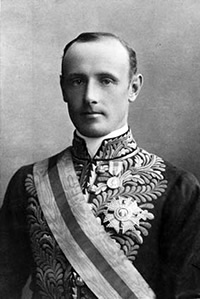137 Presentation for assent
A bill originated in the Senate and finally passed by both Houses shall be printed and presented by the President to the Governor-General for assent, having been certified by the Clerk accordingly.
Amendment history
Adopted: 19 August 1903 as SO 237 but renumbered as SO 235 for the first printed edition
Amended: 1 September 1937, J.44 (to take effect 1 October 1937) (removal of requirement for the President to certify bills, as well as the Clerk, before presentation for assent)
1989 revision: Old SO 246 renumbered as SO 137; language modernised and expression considerably streamlined
Commentary

The Earl of Hopetoun, first Governor-General of the Commonwealth of Australia, to whom President Baker wrote suggesting a form of words for the Royal Assent (Source: National Library of Australia)
The House in which a bill originates is responsible for processing it through the final stage of assent once it has passed both Houses. This contrasts with practices in some jurisdictions where one House is responsible for organising assent to all bills, regardless of their origin. This, and responsibility for custody of all original Acts, is sometimes the basis for the Clerk of that House to be known by the title of Clerk of the Parliaments, a title which is long obsolete in the Commonwealth Parliament.[1]
One aspect of the original standing order that was removed in 1937 was the requirement for the President, as well as the Clerk, to certify a bill before it was presented for assent. As Senator Sampson (UAP, Tas) explained in moving the amendment on the recommendation of the Standing Orders Committee, the changes reflected the practicalities of the circumstances:
It is unusual to require the President to sign copies of bills to be presented for assent, and, in practice, it has been found to present difficulties, owing to the time necessary for obtaining a fair print of the bill. The Standing Orders of the House of Representatives require the signature of the Clerk only. I understand that this is also the practice in most other parliaments.[2]
While the standing order refers to bills being presented by the President for assent, this is now done by letter. The practice of a President presenting bills to the Governor-General for assent in person has not been followed since the earliest years of the Commonwealth. Early correspondence from President Baker to Speaker Holder suggested practices to be adopted for the presentation of bills for assent as follows:
-
That we should formally
[“personally” inserted by hand] present to His Excellency all Bills which originated in our respective Houses, if His Excellency is in Melbourne;
-
That if His Excellency is not in Melbourne, the Clerks of the respective Houses should formally
[“personally” inserted by hand] present the Bills to the Private Secretary.
[3]
Currently, the President signs a letter of transmittal and the copies of the bill for signature are taken to the Governor-General by staff courier.
The certificate takes the following form:
I certify that this bill originated in the Senate and has been finally passed by the Senate and the House of Representatives.
Clerk of the Senate
In the name of Her Majesty, I assent to this Act.
Governor-General
2009
In some circumstances, assent is given by a Deputy of the Governor-General or by the Administrator and the certificate is varied accordingly.
President Baker took a keen interest in the constitutional relationships of the new institutions of the Commonwealth. On 19 June 1901, he wrote to the Governor-General, Lord Hopetoun, about the words to be used to signify assent. The letter is reproduced in full:
To His Excellency the Governor-General
My dear Lord Hopetoun,
I venture to call your attention to a point which may perhaps escape your notice.
The theory in Great Britain, and in all the Colonies possessing responsible Institutions has hitherto been that the Crown makes laws with the advice and consent of the Houses of Legislature.
Enclosed is a copy of “Notes on the Constitution of South Australia,” dealing inter alia with this subject (see page iv Bills, theory of).
The words hitherto used by the Representative of the Crown “I assent to this Bill” (or similar words) were and still are quite appropriate under the States’ Constitutions, but in the Federal Constitution it is otherwise.
By section 1. “the legislative power is vested in a Federal Parliament which shall consist of the Crown [sic.], a Senate, and a House of Representatives.” The Crown therefore under our Federal Constitution does not assent to a law which the Federal Houses of Legislature advise should be made – there is a coordinative power in the making of a law. The King, the Senate, and the House of Representatives, must each take their share in the making of such law; and I therefore respectfully suggest that when a Bill or proposed law is brought to you the words “I concur” or some equivalent words should be used.
I have the honor [sic.] to be,
My dear Lord Hopetoun
[R C Baker][4]
As s.58 of the Constitution requires the Governor-General to declare, inter alia, that he assents in the Queen’s name, Baker’s suggested alternative was probably never seriously considered.
See Australian Senate Practice, 6th edition, pp.517–21 for further analysis of the issues raised by this standing order.